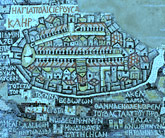
The Hurva Synagogue was the largest in the Old City of Jerusalem until it was destroyed by the Jordanians after the 1948 War of Independence along with almost every other Jewish synagogue, home, and building. Shortly after Israel captured the Old City in the 1967 Six Day War, a small portion of the synagogue was rebuilt: a single arch that became a familiar sight on the Jewish Quarter skyline. That arch was recently removed when builders began the complete restoration of the synagogue to its former glory.
Continue Reading »Bridges for Peace reported on a trip to a mysterious location in an Israeli military firing zone to investigate a series of tunnels found there in the November-December issue of the Dispatch from Jerusalem. We could not reveal the location then because it was not officially published yet. Information about that site was published in the September-October 2006 issue of Biblical Archaeology Review, so we are now happy to share the full story.
Continue Reading »
{image_1}It always amazes me what beauty man can create out of almost anything, but when you think of painting, you think of a brush, oils, and watercolors. However, in India, they “paint” with colored rice powder or sand, drawing a new “rug” outside the entrance of their home every morning as a “welcome mat” for their gods. But much of the ancient world used a different medium for “painting”—stone. I have seen many “stone paintings,” or mosaics, here in Israel. Each time, I was amazed at the workmanship and thought what a painstaking job it must have been.
Continue Reading »During the recent construction of the Holyland Park Project near Jerusalem’s Malcha shopping mall, archaeologists identified several graves from the Intermediate Bronze Age (2200–2000 BC). Each of the 40 “shaft graves,” typical of the period, extended about 2 meters (6.5 feet) down and opened into individual burial chambers. Pottery found inside the graves indicates that they were reused by later inhabitants of the area during the Middle Bronze IIB period (1750–1550 BC). Since the graves were determined not to be Jewish in origin, they will be carefully documented, the finds removed for further study, and the bodies reinterred before construction resumes.
Continue Reading »Haifa was in the headlines for all the wrong reasons during the war with Hizbullah. The region was peppered with Katyusha rockets and towns like Kiryat Shmona became household names because of television coverage of the bombing and destruction. One miracle to emerge from the war was the preservation of archaeological sites and the discovery of a new one.
Continue Reading »Most of us go through a stage when we collect coins. Quite a few make a great career of it. Israel has some interesting coins to make any collection sparkle.
Continue Reading »In the January-February issue of the Dispatch, we wrote about the oldest Christian church discovered in Megiddo prison, which includes an inscription in a mosaic that says, “The God-loving Aketous has offered this table to the God Jesus Christ as a memorial.” It is the first time, anywhere in the world, that the name of Jesus has been found in a mosaic.
Continue Reading »After several years of lying idle, excavations have resumed at Kibbutz Ramat Rachel and have yielded significant results. Ramat Rachel is located southeast of Jerusalem between the Old City and Bethlehem. Burial caves, a Byzantine church, a palace from the Judean Monarchy period, and pottery from the post-Babylonian exile period were found in previous digs.
Continue Reading »Just before the summer break, a group of Jewish and Arab fifth and sixth graders unearthed a mosaic floor as part of a year-long archaeological enrichment program, sponsored by the Israel Antiquities Authority.
Continue Reading »At the end of April, the Caesarea Development Corporation opened up the world’s first underwater archaeological museum on Israel’s northern shoreline. Thirty-six underwater sign posts, providing information for each artifact, mark four trails in the 87,000 square-yard (73,743-sq. meter) area.
Continue Reading »All logos and trademarks in this site are property of their respective owner. All other materials are property of Bridges for Peace. Copyright © 2025.
Website Site Design by J-Town Internet Services Ltd. - Based in Jerusalem and Serving the World.